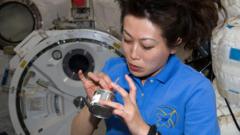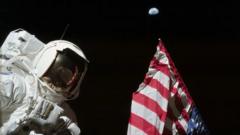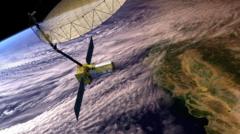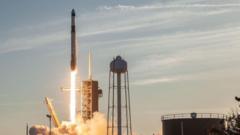The experiment could pave the way for sustainable food sources beyond Earth as space exploration expands.
Food from the stars: Growing lab-cultivated cuisine in space

Food from the stars: Growing lab-cultivated cuisine in space
An innovative ESA mission explores the feasibility of producing food in low gravity for astronauts.
In a bold leap towards sustainable space exploration, a groundbreaking experiment launched today seeks to cultivate food in the unique conditions of outer space. The European Space Agency (ESA) has initiated this project to investigate the challenges and possibilities of growing lab-cultivated foods in environments filled with low gravity and elevated radiation levels. This venture comes in response to the staggering costs of feeding astronauts, which can reach up to £20,000 daily.
The team behind the initiative envisions that successful outcomes could lead to the establishment of a prototype food production facility aboard the International Space Station (ISS) within the next two years. “The objective is to facilitate a future where humans can thrive on other planets,” stated Dr. Aqeel Shamsul, CEO of Bedford's Frontier Space, in collaboration with researchers from Imperial College London.
Current lab-grown food technology has made strides on Earth, where products like processed chicken and steak are making waves in the culinary market. However, in space, the primary driver for this push is the exorbitant expense of transporting food. Dr. Shamsul emphasized that building self-sustaining food systems in space would be crucial for long-term missions to locations such as the Moon and Mars, stating, “Producing food in situ would significantly reduce costs.”
The ESA experiment, aboard a SpaceX Falcon 9 rocket, aims to replicate the Earth-based process of precision fermentation, where controlled fermentation yields various food components without traditional agricultural methods. The mission involves a bioreactor containing engineered yeast, launched as part of the mission's payload, that will orbit Earth before being recovered off the coast of Portugal.
After acquiring the experimental data, the team plans to develop a more advanced bioreactor for future missions. However, aesthetic challenges persist, as the current product—a gooey, brick-colored mixture—might not entice discerning astronaut palates. To tackle this, culinary expert Jakub Radzikowski from Imperial College is experimenting with alternative starches and proteins to create appetizing dishes, with the hope of introducing lab-grown components once regulatory approval is granted.
In collaboration, Britain’s first astronaut, Helen Sharman, has been sampling the innovative recipes and expressed optimism, noting that while current astronaut diets often lack flavor, lab-grown alternatives could hold the key to variety and nutrition in space. “Having appetizing dishes can significantly enhance the quality of life for astronauts,” she observed, highlighting how lab-grown foods could potentially meet the unique nutritional needs of astronauts on extended missions.
As the ESA experiment progresses, it holds immense promise not only for culinary advancement but also for establishing sustainable life-support systems as human presence in space evolves. With innovative food technology poised to reshape how we think about feeding astronauts, the dream of enhanced off-world living becomes one step closer to reality.
The team behind the initiative envisions that successful outcomes could lead to the establishment of a prototype food production facility aboard the International Space Station (ISS) within the next two years. “The objective is to facilitate a future where humans can thrive on other planets,” stated Dr. Aqeel Shamsul, CEO of Bedford's Frontier Space, in collaboration with researchers from Imperial College London.
Current lab-grown food technology has made strides on Earth, where products like processed chicken and steak are making waves in the culinary market. However, in space, the primary driver for this push is the exorbitant expense of transporting food. Dr. Shamsul emphasized that building self-sustaining food systems in space would be crucial for long-term missions to locations such as the Moon and Mars, stating, “Producing food in situ would significantly reduce costs.”
The ESA experiment, aboard a SpaceX Falcon 9 rocket, aims to replicate the Earth-based process of precision fermentation, where controlled fermentation yields various food components without traditional agricultural methods. The mission involves a bioreactor containing engineered yeast, launched as part of the mission's payload, that will orbit Earth before being recovered off the coast of Portugal.
After acquiring the experimental data, the team plans to develop a more advanced bioreactor for future missions. However, aesthetic challenges persist, as the current product—a gooey, brick-colored mixture—might not entice discerning astronaut palates. To tackle this, culinary expert Jakub Radzikowski from Imperial College is experimenting with alternative starches and proteins to create appetizing dishes, with the hope of introducing lab-grown components once regulatory approval is granted.
In collaboration, Britain’s first astronaut, Helen Sharman, has been sampling the innovative recipes and expressed optimism, noting that while current astronaut diets often lack flavor, lab-grown alternatives could hold the key to variety and nutrition in space. “Having appetizing dishes can significantly enhance the quality of life for astronauts,” she observed, highlighting how lab-grown foods could potentially meet the unique nutritional needs of astronauts on extended missions.
As the ESA experiment progresses, it holds immense promise not only for culinary advancement but also for establishing sustainable life-support systems as human presence in space evolves. With innovative food technology poised to reshape how we think about feeding astronauts, the dream of enhanced off-world living becomes one step closer to reality.

















